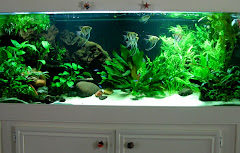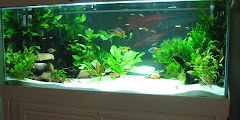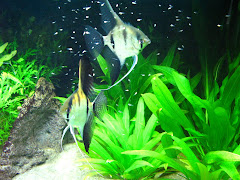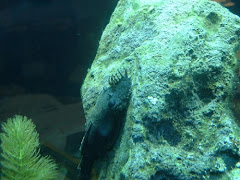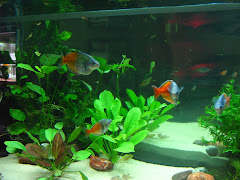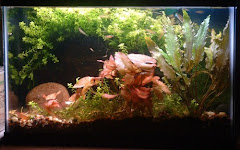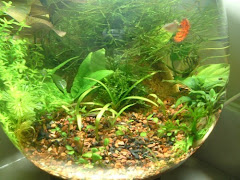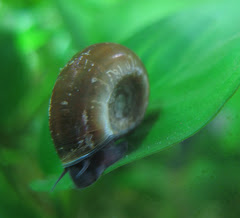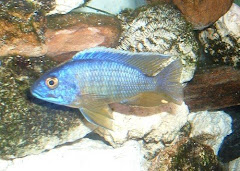I know this is an obvious statement, since most of us are keeping the fish we like, right?
However, I've recently come to the realization that there have been tanks I've kept with fish that I did not necessarily like, but that were appropriate for a setup that I liked. There are quite a few common aquarium species that I simply don't like, and I avoid those, since it is easy enough to do, with the myriad species available these days. On the other hand, once you've kept this type of setup and that type of setup, the community planted tank and the rocky Malawi cichlid tank, the species tank and the mixed tank, you start to have a desire for specific setups that appeal to you, or just ones that you've not kept before.
A couple of years ago I got a great deal on a large tank, a 150-gallon, with hood and stand, and suddenly I had new options. Fish that I could not keep before suddenly became a possibility. I started thinking how cool it would be to keep a large "tankbuster" type fish that would come up to me, begging to be fed; a fish that could be given a name and treated like a real pet. I thought about Astronotus ocellatus, the oscar cichlid, but they can be tough on tankmates and tough on aquarium decor. As mentioned, I like my aquariums to be as much an attractive display as a habitat, and I've heard stories of objects being banged around by oscars, heaters broken, plants uprooted, etc. Hmmm. Maybe not for me this time.
I've always had a thing for Tanganyikan cichlids, and the idea of a frontosa tank began to take hold. They get large and are relatively peaceful. The concept was born. I began my research and saw photos of grotesque humps on the foreheads of mature specimens, and was not terribly thrilled. Some people really like the humps - the bigger the better - but this did not appeal to me. These seemed to be most prevalent in the Burundi variety, and I set my sights on some other collection points, like Moba and Kapampa, which have a richer blue and less prominent humps, typically. I admired the look of some of the Moba setups, with rocks, dim lighting, sand and the graceful large blue striped fish cruising around. The tanks have a minimalist, simple look to them that appealed to me, after so many busy, high-light, heavily planted tanks that I've kept.
Since the frontosa get so big, it is not advised to keep smaller species with them, but often people have success with the Altolamps, (calvus and compressiceps), as long as you stick to the larger males. These are fish I truly admire, with their sloped foreheads and downturned mouths - the bulldog look that I like so much! So I set up the tank with frontosa and altolamprologus species, hoping that as the altolamps grew they'd hang out in the rocks for safety.
I had a lot of trouble with the frontosa. My first shipment of very young specimens died almost immediately - which was quite a bit of money down the tube, though the dealer replaced the fish. I was out shipping, and that was not a small amount, at least for me. I lost almost all of the second shipment too, but 4 survived out of 10. *Sigh* So, nothing but stress from the beginning with these fronts. Constant worry about whether they'd survive and thrive, and whether I could get this tank to where I wanted it. I had the monolithic rock formations, the dim lighting and the sand, and all I needed was the fish to grow and glide around!
One thing about Tanganyikan cichlids is that many of them are shy and dash for cover when you approach the tank. This has never bothered me too much, since they get used to you and will gradually come back out so you can see them. For fish like Brichardi sp., this was well worth it, with their interesting coloration and fin extensions - gorgeous. Same for the calvus and the comps. Such an impressive look to them, and some with polka dots and red or yellow hues. I could watch a mature calvus all day long.
Well, here I am with this large tank in my living room, and it looked completely empty! I had 4 Kapampa frontosa and about 11 various small Tang cichlids in it, most altolamps but 6 Paracyprichromis nigripinnis and one Neolamprologus leleupi. All of them hide, including the frontosa. While the fish were small they hid in the rocks with the rest of them, and would only dart out at feeding time, grabbing a mouthful and dashing back into hiding. Oh well, I told myself, once the fronts get big they won't be able to fit behind the rocks and they'll be forced to stay out in the open where I can see them.
Then came the recent dreadful tank disaster (I still do not know the cause of this tragedy!) and I lost all the Tang cichlids in about 12 hours. The idea of starting over crossed my mind, but slowly I realized the truth: I don't really LIKE frontosa! They have a blunt, bloated look to them that I don't like, but they needed to be the centerpiece to my Tanganyikan display tank, so I went with them anyway. Add to this the fact that Tang cichlids are sensitive to any change in water parameters, diet, etc., and I always had an underlying worry that something would go wrong with the tank; this was enough to lessen the enjoyment I got out of watching it.
This came into sharp focus when I got my new additions, the Geophagus sp. orange head "Tapajos." They gave me a very familiar scare initially (I was instantly brought back to the failed frontosa shipment) but came around once I raised the temperature, and now they are doing great. These are hardier fish than Tang cichlids, and I don't see a reason why I won't get them to maturity. They come rushing over to the glass at your approach, begging for food, and will follow you back and forth.
Also, I really LIKE the Geophagus and Satanoperca species complex, with the sloped foreheads, spangled and striped coloration, and oftentimes long, trailing fin extensions. Mature specimens are gorgeous. A couple of years ago I saw a mature Satanoperca daemon at a shop in Lynchburg, and ever since then I vowed I'd keep them someday. Fish that have a wild or native look to them definitely appeal to me more than some of the more ornamental species available now. No long-fins, balloon bellies, or koi colorations for me, thanks. I am not particularly opposed to hybrids, but I prefer fish as they'd be found in the wild.
I am now evaluating my tastes and preferences more carefully, and realize that I really like wild or wild-type angels, be they scalare, altum or leopoldi. I don't have much interest in domestic angels. I have come very close several times to purchasing some Apistogramma species as well, since my 40-gallon is a very appropriate setup for them, but I now realize that Apistos are not very appealing to me, surprisingly. They can be gloriously colored and have interesting personalities, but I don't really like them, much like I don't care for Kribensis (Pelvicachromis pulcher). I can't explain why I don't like them, but something about the torpedo body shape turns me off.
I do like my Bolivian ram, perhaps mainly because he's actually alive (if you've kept rams before you may know what I'm talking about) and because he's wild I consider him to be like they'd be in nature. That's as close to a dwarf cichlid as I'll likely get anytime soon.
Another admission I'll make: I'm not such a big fan of catfish. I like cory cats in planted setups where I'm not trying to raise a spawn, and I had a whiptail cat that was absolutely fascinating and a gorgeous specimen (look back in the blog to see that amazing fish), but currently I have no catfish at all, and though I'm not ruling them out completely, they are not a species I need to have. For many years I considered some type of catfish to be essential to most any setup, to occupy the bottom and to "clean up" leftovers. I've had some interesting catfish before but I don't require them. Maybe I've just not kept some of the more interesting species, like Hara jerdoni, or the Asian Stone Catfish. My friend has those and they are absolutely adorable! Maybe I'll limit myself to Corydoras species and hold out for a truly interesting specimen catfish.
This entire post is silly but I wanted to share my ideas and where I am in the hobby these days. I tend to set up tanks hastily, without a lot of planning, and just think it would be neat to have certain fish in a certain type of setup. Now I think I'll consider more carefully - not only because I have less time to devote to the hobby but also because I don't want to waste time on fish that don't make me happy. All my tanks, save the pair of N. leleupi that don't seem to want to spawn for me, make me happy, truly happy, including my two tanks of wonky round goldfish, and that's a good thing.
Friday, December 9, 2011
I've Got Sunshine - In a Cloudy Tank
The Tapajos are still doing great, and showing more hints of color. They are very, very active, almost manic, and spend a lot of time doing what geophagus do - digging through the sand.
When I set up this tank with the frontosa, I rinsed this sand as well as I could, but eventually tired of the rinsing and gave up on it. It is extremely fine sand and contains a great deal of dust. Every time I would stir the sand to keep it aerated it would produce a mild cloud that would soon dissipate with the heavy filtration. For years the sand was no problem, without any fish disturbing it, so hours of rinsing was not required for the setup
Now, with the sand being constantly disturbed by this eartheater species the tank carries a constant haze. I was alarmed about it at first - thinking my water quality was suffering somehow, but diligent testing of all parameters showed normal and desirable results, confirming that there is no ammonia or nitrite, and 5 ppm nitrate. Hardness, buffering capacity and pH are all as expected - a little higher than a typical SA cichlid might prefer, but not too far off. I don't even suspect a bacterial bloom, since this tank is past that stage, which I went through with the goldfish..
So, the sand is the culprit, and I'm not sure what to do, if anything. I'm tempted to aggressively dig through it myself, attempting to release all of the dust at once, do a big PWC and see if that helps, or I can simply let the fish do it slowly over time, which might be the more sensible approach. My tanks are, for me, an artistic display as much as a habitat, so a cloudy tank is hard for me to ignore, but I don't want to cause problems for these wee fish, either. Massive disturbance of the substrate followed by a large PWC could upset the bacterial colonies enough to cause a mini cycle.
I'm sure over time the dust will be filtered out, but it could take a while. Right now the sifting of the sand by the fish is superficial, since the fish are so very small, and as they grow they'll dig down deeper and take bigger mouthfuls as they sift, searching for morsels.
In spite of all that, my little orange heads (the sunshine!) are content and give me a lot of pleasure, and this minor issue is one that will resolve itself before too long.
When I set up this tank with the frontosa, I rinsed this sand as well as I could, but eventually tired of the rinsing and gave up on it. It is extremely fine sand and contains a great deal of dust. Every time I would stir the sand to keep it aerated it would produce a mild cloud that would soon dissipate with the heavy filtration. For years the sand was no problem, without any fish disturbing it, so hours of rinsing was not required for the setup
Now, with the sand being constantly disturbed by this eartheater species the tank carries a constant haze. I was alarmed about it at first - thinking my water quality was suffering somehow, but diligent testing of all parameters showed normal and desirable results, confirming that there is no ammonia or nitrite, and 5 ppm nitrate. Hardness, buffering capacity and pH are all as expected - a little higher than a typical SA cichlid might prefer, but not too far off. I don't even suspect a bacterial bloom, since this tank is past that stage, which I went through with the goldfish..
So, the sand is the culprit, and I'm not sure what to do, if anything. I'm tempted to aggressively dig through it myself, attempting to release all of the dust at once, do a big PWC and see if that helps, or I can simply let the fish do it slowly over time, which might be the more sensible approach. My tanks are, for me, an artistic display as much as a habitat, so a cloudy tank is hard for me to ignore, but I don't want to cause problems for these wee fish, either. Massive disturbance of the substrate followed by a large PWC could upset the bacterial colonies enough to cause a mini cycle.
I'm sure over time the dust will be filtered out, but it could take a while. Right now the sifting of the sand by the fish is superficial, since the fish are so very small, and as they grow they'll dig down deeper and take bigger mouthfuls as they sift, searching for morsels.
In spite of all that, my little orange heads (the sunshine!) are content and give me a lot of pleasure, and this minor issue is one that will resolve itself before too long.
Sunday, December 4, 2011
The Tapajos are Here!
My shipment of Geophagus sp. Orange Head "Tapajos" have arrived, and they are marvelous specimens. I ordered 20, but our best count keeps coming up 26, so that's quite a few extra!
Initially they were cold, and I was concerned for an hour or two but once I got the temperature up to 82 they perked right up, and have been right as rain ever since. They are always ravenous, and seem happy.
Once they get some size I'll definitely need to remove at least 16, since I think 10 individuals will be plenty for this tank, but we'll wait and see. They're already showing a hint of the red coloration they'll have as adults, and are literally all over the tank exploring. I look forward to moving my leopoldi angel into this tank, and finding more wild or wild type angels, and am considering catfish, maybe panaque types, but not if I hope to raise a spawn, so that decision will come later. I may stick to only cichlids, and keep the geos for the bottom and angels for the top. I' may also move my Bolivian ram down into this tank as well to give the blue rams a little peace in the 40-gallon.
Right now the geophagus are settling in and I don't want to disturb the tank at this point, but will watch as they grow and the tank matures a bit.
Initially they were cold, and I was concerned for an hour or two but once I got the temperature up to 82 they perked right up, and have been right as rain ever since. They are always ravenous, and seem happy.
Once they get some size I'll definitely need to remove at least 16, since I think 10 individuals will be plenty for this tank, but we'll wait and see. They're already showing a hint of the red coloration they'll have as adults, and are literally all over the tank exploring. I look forward to moving my leopoldi angel into this tank, and finding more wild or wild type angels, and am considering catfish, maybe panaque types, but not if I hope to raise a spawn, so that decision will come later. I may stick to only cichlids, and keep the geos for the bottom and angels for the top. I' may also move my Bolivian ram down into this tank as well to give the blue rams a little peace in the 40-gallon.
Right now the geophagus are settling in and I don't want to disturb the tank at this point, but will watch as they grow and the tank matures a bit.
Subscribe to:
Posts (Atom)

